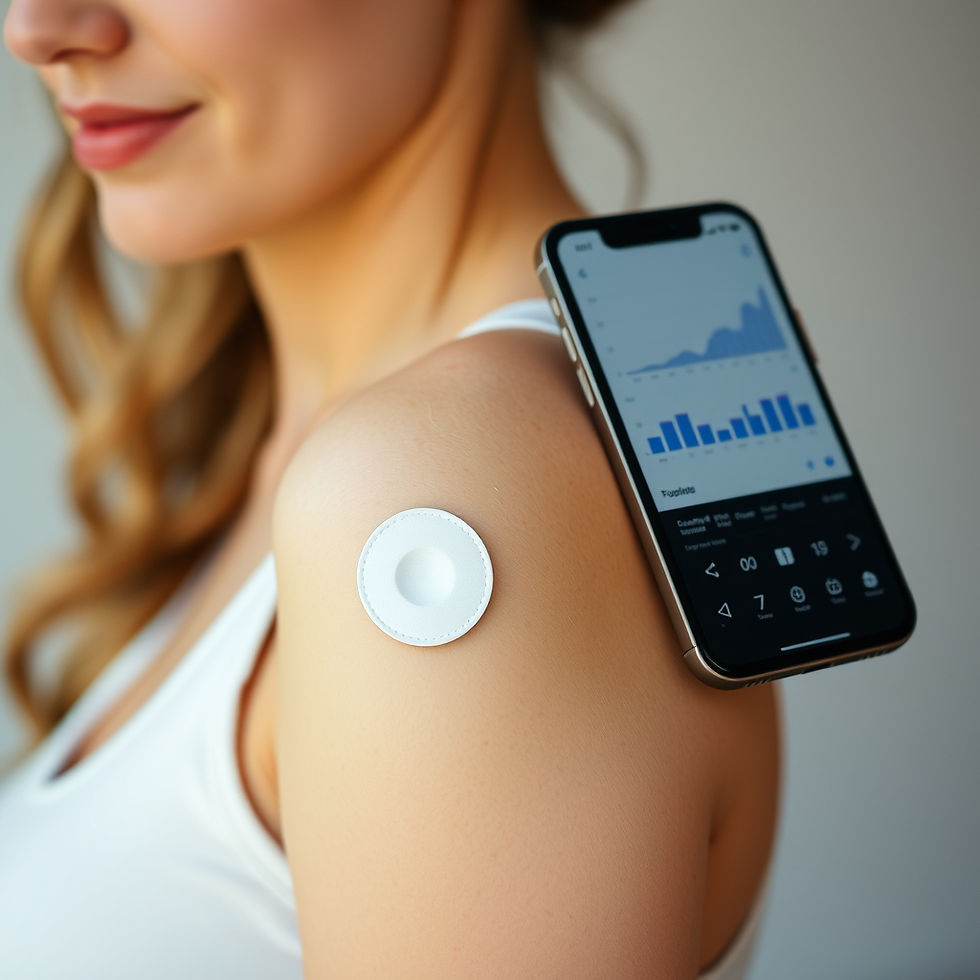Are continuous glucose monitors for everyone?
- Saneka Chakravarty, MD, FACC
- Jul 22
- 4 min read
Updated: Jul 31

Continuous glucose monitors are ubiquitous, appearing in weight loss programs and among influencers on TikTok, sparking widespread discussion. Monitoring continuous glucose levels and their variations, especially in response to specific foods, has garnered a significant fan base. This trend has captured the interest of entrepreneurs, who have invested time and effort, almost gamifying the experience, as people are fascinated by the workings of the human body, which is undeniably intriguing to observe. However, does this truly aid in weight loss or the correction of metabolic disorders? What does the scientific community have to say about it?
Benefits of continuous glucose monitors(Supported by Clinical Trials)
People with Type 1 Diabetes (T1D): Randomized trials have shown CGMs can reduce HbA1c by about 1.0% compared with traditional self-monitoring, and reduce time spent in dangerously low (hypoglycemic) or high (hyperglycemic) glucose ranges .
The HbA1c test reflects a person's average blood sugar levels over the preceding 2 to 3 months. This test is a valuable tool for diagnosing, managing, and monitoring diabetes
Insulin-treated Type 2 Diabetes (T2D): Similar trials found HbA1c improvements of 0.5–0.7% in adults with T2D using CGM versus finger-stick testing .
Hypoglycemia(low blood sugar) risk: For those with frequent or unrecognized lows (e.g. hypoglycemia unawareness or night time hypoglycemia), CGM with alerts improves safety .
Adherence matters: Users who consistently wear their device derive significantly greater benefits; gaps in wear are associated with poorer outcomes .
Limitations & Concerns
Children and adolescents: Meta-analyses have found little to no significant HbA1c benefit in younger people using CGMs .
Accuracy issues: CGMs sample interstitial fluid (not blood), and accuracy can deviate by ~20‑30%—especially during rapid glucose changes. Pressure on the sensor (“compression lows”) can lead to false readings .
User burden: Numeracy, alarm fatigue, adhesive skin irritation, data anxiety, and discontinuation are common challenges for real-world users .
CGMs for Non‑Diabetic Individuals: The Data
Evidence Against Use in Healthy or Low‑Risk Populations
A 2024 narrative review evaluating CGMs in people without diabetes found no consistent high-quality evidence supporting their use for early detection or behavior change. The authors conclude commercial claims are misleading and call for stronger oversight .
A University of Bath study compared CGM data with finger-stick tests in healthy volunteers and reported ~30% overestimation of blood sugar—potentially causing unnecessary worry or dietary restriction .(https://pubmed.ncbi.nlm.nih.gov/40021059/)
Experts caution that in non-diabetics, natural glucose fluctuations are expected and pose no health risk. There’s little evidence CGMs improve outcomes—and they may fuel unhealthy obsessions with numbers and eating disorders.
Real-World Reports
Users on forums report CGMs causing stress, anxiety, and unnecessary dietary restriction in those without metabolic disease. Some describe skin irritation and discomfort from adhesives .
Who Gains Most (and Least) from CGMs?
Evidence‑Based Benefit -
Adults with Type 1 Diabetes or insulin‑treated Type 2 Diabetes-Substantial HbA1c reduction, hypoglycemia prevention, quality‑of‑life gains
Requires consistent wear; insurance and training barriers for adoption
Limitations or Low Benefit-
Children with Type 1Diabetes-May help but evidence is less clear; benefit more modest in youth
Lower adherence; accuracy challenges; sometimes no HbA1c reduction
Yet to be have any proven Benefit-
People without diabetes (“wellness users”)-Risks of anxiety, misinterpretation, unnecessary restriction, cost burden
Final Recommendations
The American Diabetes Association recommends CGM for all people with type 1 diabetes and for adults with type 2 diabetes using insulin, as CGM improves glycemic control (lower HbA1c), increases time in range (TIR), and reduces hypoglycemia and acute metabolic events. CGM also provides real-time alerts for hypo- and hyperglycemia, supports individualized therapy adjustments, and improves patient satisfaction and quality of life.[1][2]
Patients who may not benefit from CGM include those with type 2 diabetes managed with lifestyle or non-insulin therapies, as the incremental benefit in glycemic control is smaller in this group. Additionally, individuals who are unable or unwilling to use the technology, have limited access due to cost, or have significant cognitive or physical barriers may not benefit. The American Diabetes Association notes that for patients on basal insulin alone or non-insulin regimens, intermittent or professional CGM may be considered, but routine use is not universally recommended.[1][3][2]
The role of CGM in individuals without diabetes is not supported by current clinical guidelines. While CGM is increasingly marketed for health and wellness, there is a lack of high-quality evidence demonstrating benefit in this population, and concerns exist regarding potential adverse effects, such as disordered eating or anxiety. The British Diabetic Association and recent reviews emphasize that commercial claims for CGM in people without diabetes are misleading and not evidence-based. Thus, CGM is not recommended for individuals without diabetes outside of research settings.[4][5][6]
References
1. Guidelines and Recommendations for Laboratory Analysis in the Diagnosis and Management of Diabetes Mellitus. Sacks DB, Arnold M, Bakris GL, et al. Diabetes Care. 2023;46(10):e151-e199. doi:10.2337/dci23-0036.
2. 7. Diabetes Technology: Standards of Care in Diabetes-2025. Diabetes Care. 2025;48(Supplement_1):S146-S166. doi:10.2337/dc25-S007.
3. Diagnosis and Treatment of Type 2 Diabetes in Adults. Kalyani RR, Neumiller JJ, Maruthur NM, Wexler DJ. JAMA. 2025;:2835629. doi:10.1001/jama.2025.5956.
4. Innovative Solution or Cause for Concern? The Use of Continuous Glucose Monitors in People Not Living With Diabetes: A Narrative Review. Oganesova Z, Pemberton J, Brown A. Diabetic Medicine : A Journal of the British Diabetic Association. 2024;41(9):e15369. doi:10.1111/dme.15369.
5. Use of Continuous Glucose Monitors by People Without Diabetes: An Idea Whose Time Has Come?. Klonoff DC, Nguyen KT, Xu NY, et al. Journal of Diabetes Science and Technology. 2023;17(6):1686-1697. doi:10.1177/19322968221110830.
6. Non-Invasive Continuous Glucose Monitoring in Patients Without Diabetes: Use in Cardiovascular Prevention-a Systematic Review. Wilczek F, van der Stouwe JG, Petrasch G, Niederseer D. Sensors (Basel, Switzerland). 2025;25(1):187. doi:10.3390/s25010187.










Hi there 👋
This is very amazing but still needs somethings to be fixed out and I'm here for you
Kindly come inbox me now for much more details
Thank you